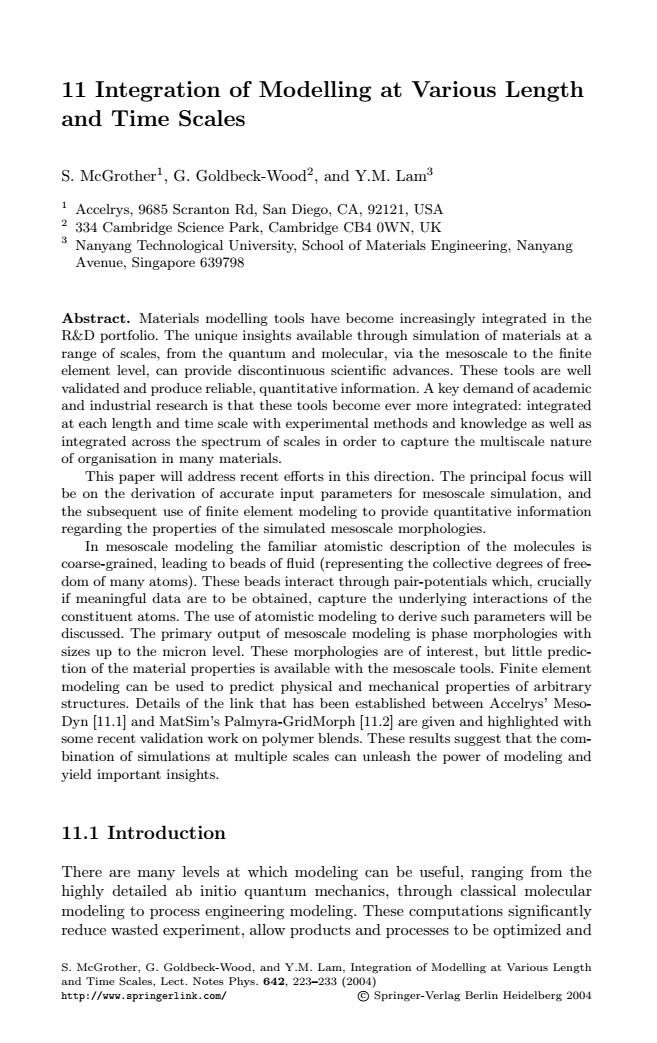正在加载图片...

11 Integration of Modelling at Various Length and Time Scales S.McGrother1,G.Goldbeck-Wood2,and Y.M.Lam3 1 Accelrys,9685 Scranton Rd,San Diego,CA,92121,USA 2 334 Cambridge Science Park,Cambridge CB4 OWN,UK 3 Nanyang Technological University,School of Materials Engineering,Nanyang Avenue,Singapore 639798 Abstract.Materials modelling tools have become increasingly integrated in the R&D portfolio.The unique insights available through simulation of materials at a range of scales,from the quantum and molecular,via the mesoscale to the finite element level,can provide discontinuous scientific advances.These tools are well validated and produce reliable,quantitative information.A key demand of academic and industrial research is that these tools become ever more integrated:integrated at each length and time scale with experimental methods and knowledge as well as integrated across the spectrum of scales in order to capture the multiscale nature of organisation in many materials. This paper will address recent efforts in this direction.The principal focus will be on the derivation of accurate input parameters for mesoscale simulation,and the subsequent use of finite element modeling to provide quantitative information regarding the properties of the simulated mesoscale morphologies. In mesoscale modeling the familiar atomistic description of the molecules is coarse-grained,leading to beads of fluid (representing the collective degrees of free- dom of many atoms).These beads interact through pair-potentials which,crucially if meaningful data are to be obtained,capture the underlying interactions of the constituent atoms.The use of atomistic modeling to derive such parameters will be discussed.The primary output of mesoscale modeling is phase morphologies with sizes up to the micron level.These morphologies are of interest,but little predic- tion of the material properties is available with the mesoscale tools.Finite element modeling can be used to predict physical and mechanical properties of arbitrary structures.Details of the link that has been established between Accelrys'Meso- Dyn [11.1]and MatSim's Palmyra-GridMorph [11.2]are given and highlighted with some recent validation work on polymer blends.These results suggest that the com- bination of simulations at multiple scales can unleash the power of modeling and yield important insights. 11.1 Introduction There are many levels at which modeling can be useful,ranging from the highly detailed ab initio quantum mechanics,through classical molecular modeling to process engineering modeling.These computations significantly reduce wasted experiment,allow products and processes to be optimized and S.McGrother,G.Goldbeck-Wood,and Y.M.Lam,Integration of Modelling at Various Length and Time Scales,Lect.Notes Phys.642,223-233(2004) http://www.springerlink.com/ C Springer-Verlag Berlin Heidelberg 200411 Integration of Modelling at Various Length and Time Scales S. McGrother1, G. Goldbeck-Wood2, and Y.M. Lam3 1 Accelrys, 9685 Scranton Rd, San Diego, CA, 92121, USA 2 334 Cambridge Science Park, Cambridge CB4 0WN, UK 3 Nanyang Technological University, School of Materials Engineering, Nanyang Avenue, Singapore 639798 Abstract. Materials modelling tools have become increasingly integrated in the R&D portfolio. The unique insights available through simulation of materials at a range of scales, from the quantum and molecular, via the mesoscale to the finite element level, can provide discontinuous scientific advances. These tools are well validated and produce reliable, quantitative information. A key demand of academic and industrial research is that these tools become ever more integrated: integrated at each length and time scale with experimental methods and knowledge as well as integrated across the spectrum of scales in order to capture the multiscale nature of organisation in many materials. This paper will address recent efforts in this direction. The principal focus will be on the derivation of accurate input parameters for mesoscale simulation, and the subsequent use of finite element modeling to provide quantitative information regarding the properties of the simulated mesoscale morphologies. In mesoscale modeling the familiar atomistic description of the molecules is coarse-grained, leading to beads of fluid (representing the collective degrees of freedom of many atoms). These beads interact through pair-potentials which, crucially if meaningful data are to be obtained, capture the underlying interactions of the constituent atoms. The use of atomistic modeling to derive such parameters will be discussed. The primary output of mesoscale modeling is phase morphologies with sizes up to the micron level. These morphologies are of interest, but little prediction of the material properties is available with the mesoscale tools. Finite element modeling can be used to predict physical and mechanical properties of arbitrary structures. Details of the link that has been established between Accelrys’ MesoDyn [11.1] and MatSim’s Palmyra-GridMorph [11.2] are given and highlighted with some recent validation work on polymer blends. These results suggest that the combination of simulations at multiple scales can unleash the power of modeling and yield important insights. 11.1 Introduction There are many levels at which modeling can be useful, ranging from the highly detailed ab initio quantum mechanics, through classical molecular modeling to process engineering modeling. These computations significantly reduce wasted experiment, allow products and processes to be optimized and S. McGrother, G. Goldbeck-Wood, and Y.M. Lam, Integration of Modelling at Various Length and Time Scales, Lect. Notes Phys. 642, 223–233 (2004) http://www.springerlink.com/ c Springer-Verlag Berlin Heidelberg 2004